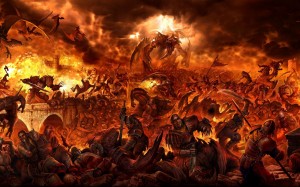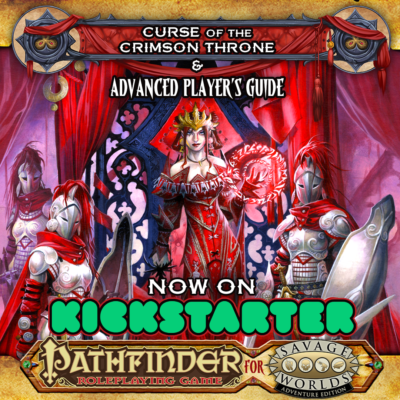En Mass
By The Warden
 War. Ugh! What is it good for? Collecting lots of minis! Say it again!
War. Ugh! What is it good for? Collecting lots of minis! Say it again!
Now that you have that song stuck in your head, let’s talk about mass combat. It’s been rolling around in my head for a while and has come to light in response to the Centurion Kickstarter stretch goal (we get to choose between an additional timeline/setting, magic rules, or mass combat rules – I voted mass combat) and the Domains At War Kickstarter launched by Autarch just the other day.
I have an ironic connection with mass combat. The concept of running extravagant battles comprised of hundreds of combatants on a field soaked in the blood of the fallen and wounded typically involves the use of miniatures, a battlemap, and other purchased or hand-crafted accessories. I’m not one for accessories. Even during my D&D days, I was never one for assembling a Rubbermaid dresser of organized minis. There are ways to “cheat” using paper minis, tokens, or do it Bill Cosby-style: “I wanna be the piece of glass!” That’s my GM viewpoint on the matter. As a player, I may have been too eager to jump into battles and I still am. I love it!
At its core, mass combat stretches the application of player control and replaces the individual character manipulated by the player into a unit of common individuals directed by a single player. Mass combat units can share many of the same abilities, stats, and mechanical concepts as individual characters save for a few key elements. Damage results in a decrease in the unit’s numbers rather than subjective wounds; individual characters can recover from their wounds, but dead soldiers remain dead.
It makes sense to see these similarities because mass combat games were the inspiration for the roleplaying game and it’s that connection, the ability to bounce back and forth between questing and battles, the has always captured my interest and imagination. What epic storyline does not involve war, particularly in the genres that captivate roleplayers the world over? Science fiction, fantasy, and medieval history are ripe with legendary tales of nations at war and civilizations battling for rights of property or domination.
One of my all-time favourite supplements for any system is Heroes of Battle from Wizards of the Coast for D&D/d20 war campaigns. It provided non-mass combat rules and guidelines for inserting our heroes into the brunt of the war campaign without the need for running mass combat every single time. The heroes could accept a mission to infiltrate enemy lines and disable their siege weapons, swipe tactical plans for the invasion, or kill their general in his sleep. These side missions would allow the sway of the oncoming battle to shift based on the individual actions of the heroes, granting bonuses or penalties to your army when they march across the field. It was awesome.
NO WAR WITHOUT SOLDIERS
The problem (personally speaking) with mass combat systems and its extensions is the role of miniatures. Most war games involve the use of miniatures, terrain, and a list of add-ons that make guys with tight wallets (like me) a bit anxious. Not because of the initial expenses and requirements needed to start up such a campaign, but the tension involved with maintaining a war campaign. Campaigns are evolving story lines built using mechanics that reward and expand heroes’ abilities, meaning as the campaign moves forward, more awesomeness is expected from both player characters and the campaign itself. In other words, more campaign, more minis. And unless Reaper is planning on offering another 500 minis for $100 anytime soon, I may have to pass.
For over a decade – give or take a year or two – I’ve pondered the idea of a non-minis war campaign/system allowing Gamemasters such as myself a cheaper and equally viable opportunity to run a war campaign without getting bogged down in accessories, yet like many concepts burrowing around in all of our brains, there hasn’t been time, opportunity, or incentive to push forward with it. One of the biggest hurdles is handling the scale and detail involved with epic battles (or even mild battles, since not everything we do has to be epic, right?). There’s a reason why these games use props because of the most influential aspect of the war campaign: position.
Position may be the biggest source of advantage in every RPG we know of. Where you stand in relation to your enemies, allies, cover, and the distance required to reach your goal defines our options. Even in a standard RPG campaign, your game may have rules for making a ranged attack against an adjacent opponent, your weapon’s range is limited by the distance between your hero and the enemy, and closing the distance between opponents in a chase scene is the entire purpose of the chase. Now elevate that to hundreds – or thousands – of combatants bulked together in chunks and you’ve taken the role of positioning to another level.
Smaller, imaginative systems designed to avoid the use of minis and other on-the-table accessories can handle positioning because it’s designed with less importance than larger systems measuring distance in squares or hexes. For example, a smaller and simpler system may simply require that you’re in the same room or that you declare your character standing adjacent to your chosen enemy. Problem solved. Providing the same concept in war may be too over-simplistic unless your army marches in a straight line and doesn’t believe in flanking, rushing the field, or taking any advantage whatsoever in battle. Without positioning, war becomes nothing more than a contest of initiative and dice rolls unless only one army remains standing.
TECHNOLOGY TO THE RESCUE…?
Yet another example of modern roleplaying games shifting into new territories is the use of computers to enhance or replace plastic figures on a physical table. Don’t have an army of minis in a box ready to rock and roll? That’s nothing Roll20 can’t fix. Simply drop an image of a battlefield on your screen and insert tokens for your armies to move around with a mouse cursor. So long as your players have access and a clear line of sight to the monitors (if you’re all at the same table), then it’s problem solved. Right?
Here’s the thing I’ve noticed about battlefield games, from those built entirely for war simulation or RPG campaigns that dabble in a war zone or two, bigger is considered better. Look at how amazingly complex and detailed these options can get (and that’s with the ironic struggle to lower production costs and deal with supply vs demand issues of the 21st Century). You don’t really think it would transfer over into new technology as well, do you? Case in point: the Microsoft Surface demo allowing players to manipulate their minis on an interactive (and huge) touch screen device. You and I both know we started having fantasies of that very device (or bigger) in our games room.
Yes, that’s completely optional. There’s no need for it, you can simply use an ordinary desk monitor propped up at your table to show a visual overhead of troop movements. Agreed. It’s the same with physical products – there’s no need to create a replica of a fictional battlefield. So why is my FLGS’ entire right side of the store loaded to the gills with miniatures, paints, terrains, ships, and more? Those are optional too, but they sell. Look at the incredible success Dwarven Forge is enjoying on Kickstarter right now and you can see we’re all jumping at the bit to get some sweet 3D terrain because sometimes battlemaps just aren’t awesome enough. When the time comes and a table-sized touch screen device is within reach of the masses, will you be able to fight the temptation?
It’s the storyteller in all of us. The campaign is an evolution of story and character, as we spoke about recently, and props can be a tool to reflect that grand evolution. At the start of a campaign, the GM could use 2D battle tiles and pre-painted plastic minis to represent the fight with a band of goblin marauders. By the end, a towering foam construction representing the wizard’s tower has been erected at the centre of the table, with each level removable to allow miniatures to move around inside and engage their enemy before she opens the portal into the Nine Hells. It’s a natural progression and while I may not be an active participant, I am incredibly jealous of those with the time, ability, and finances to pull it off. Kudos to you, GM. Kudos.


Mass combat is always difficult to run in a roleplaying setting. Perhaps its the wargamer in me, but I feel like I’m always lacking in granularity when roleplaying a mass combat.
Have you ever looked at the old Swords and Spells rules put out for OD&D?
Haven’t had the pleasure personally, but I do recall a DM (from waaaay back in the day) talking about it and using it in his campaign.